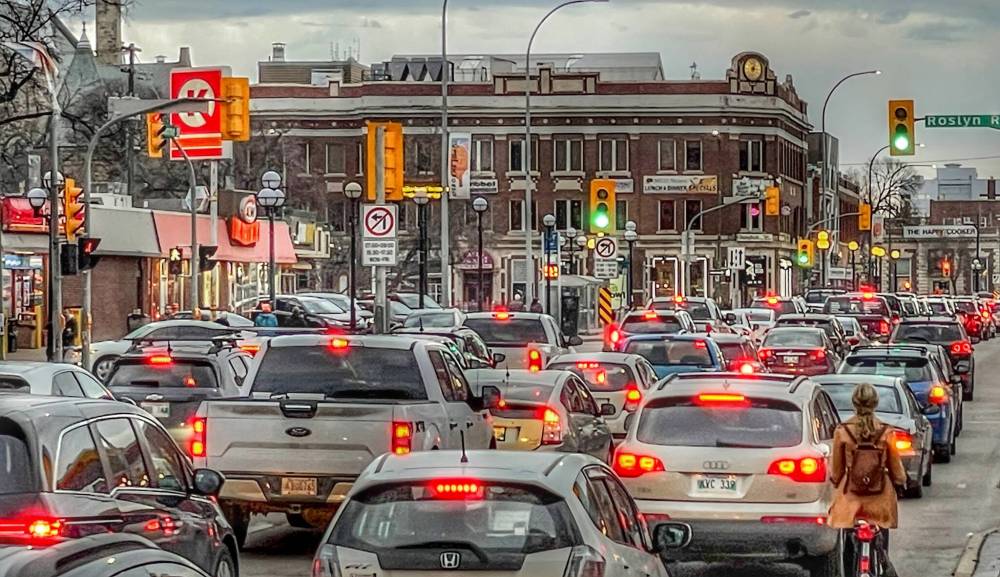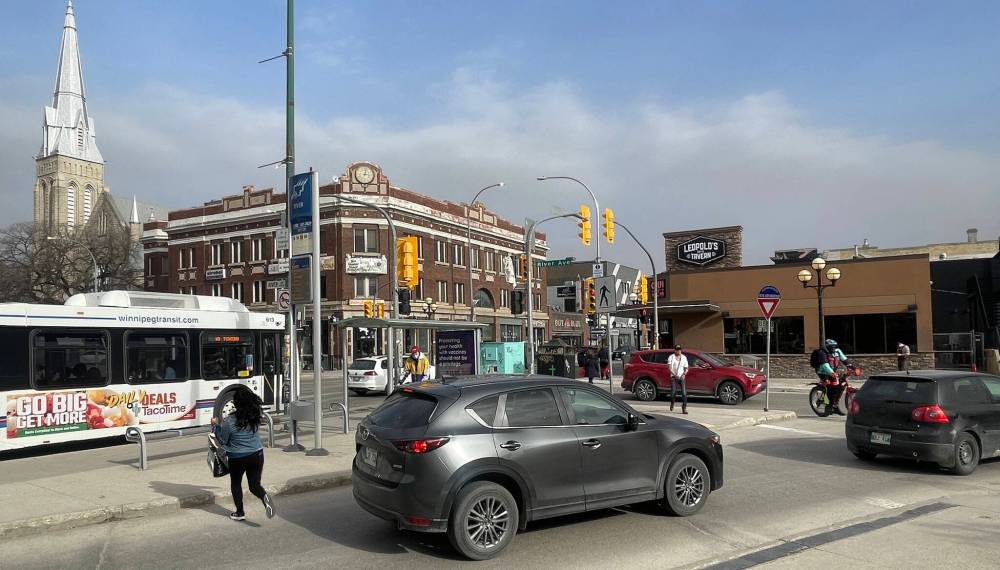City should scramble to transform important Village intersection
Advertisement
Read this article for free:
or
Already have an account? Log in here »
To continue reading, please subscribe:
Monthly Digital Subscription
$19 $0 for the first 4 weeks*
- Enjoy unlimited reading on winnipegfreepress.com
- Read the E-Edition, our digital replica newspaper
- Access News Break, our award-winning app
- Play interactive puzzles
*No charge for 4 weeks then billed as $19 every four weeks (new subscribers and qualified returning subscribers only). Cancel anytime.
Read unlimited articles for free today:
or
Already have an account? Log in here »
Now that there seems to be some resolution for the future of Portage and Main, there is another important urban intersection we should talk about.
The corner of River and Osborne is the gateway to Osborne Village, Winnipeg’s highest-density neighbourhood and a rare walkable, complete community in the city. In our collective imagination, the Village strip is a street with bustling sidewalks and vibrant public spaces, set around a series of eclectic shops and restaurants.
The reality of Osborne, however, is a street that has become a vehicle canyon, with pedestrians anxiously clinging to the edges along narrow and treeless sidewalks.

We have intentionally made design choices that prioritize driving through the neighbourhood over creating a place that invites people to walk, shop and linger. Those choices begin with the intersection.
Instead of being the anchor that draws people to the heart of the strip, the River and Osborne intersection has become one of the most dangerous places for pedestrians in the city — typically ranking second or third for most pedestrian/vehicle collisions each year.
Instead of being the anchor that draws people to the heart of the strip, the River and Osborne intersection has become one of the most dangerous places for pedestrians in the city.
Recognizing that a prosperous future for the Village requires a change in priorities, last year, the Osborne Village BIZ created the Blueprint for a Healthy Neighbourhood. The action plan outlines ways to begin making the Osborne strip a true neighbourhood high street, creating a renewed sense of place and prioritizing the human experience.
It proposes to make the River and Osborne intersection safer by adding a pedestrian scramble crossing and closing the right-turn vehicle slip lane. In late 2023, Couns. Janice Lukes and Sherri Rollins introduced a committee motion directing the public service to study these two ideas and develop a pedestrian prioritized pilot project for the intersection.
Scramble crossings are becoming popular interventions across the country, where high numbers of pedestrians and vehicles mix. They have been implemented on other urban shopping streets such as Whyte Avenue in Edmonton, Robson Street in Vancouver, and Yonge Street in Toronto.
Scramble crossings make intersections safer by creating an exclusive pedestrian crossing phase where vehicles are stopped at every corner and pedestrians cross all at once in all directions, including diagonally.
This strategy was felt to be appropriate for River and Osborne because it would mean vehicles and pedestrians never cross the street at the same time, increasing pedestrian comfort, and significantly reducing interactions that result in collisions.
Removing slip lanes is something that is happening across North America as cities accept how unsafe and uncomfortable they are for pedestrians and cyclists. Slip lanes are the unsignalized and dedicated lanes at intersections that allow drivers to turn right without stopping, typically creating a small island between it and the corner.
Like at River and Osborne, we often locate transit stops on these islands, forcing people to huddle uncomfortably in a whirlpool of vehicles cycling around them.
Slip lanes are the physical manifestation of street design that prioritizes vehicle speed over the safety of all other road users.
Slip lanes are the physical manifestation of street design that prioritizes vehicle speed over the safety of all other road users. They are highway infrastructure that has no place in urban neighbourhoods. Eliminating slip lanes is not only an important consideration at River and Osborne, but wherever they exist in residential neighbourhoods across the city.
As a driver, consider where your eyes are when you move through a slip lane. As you turn right, you are most likely looking left down the street to find an opening in traffic that you can accelerate into.
Now, as a pedestrian, consider where you want a driver’s eyes to be as you step into the street and cross in front of their vehicle. You want the driver to look forward and directly at you, but slip lanes are designed to allow cars to maintain their speed while diverting the driver’s attention away from their direction of travel.
This is why they are so dangerous.

An intersection is where all road users — cyclists, pedestrians, and drivers — are occupying the same space. It is vital at that moment each person is acutely aware of what’s happening directly in front of them.
When you cross a street with a slip lane, you are forced to cross through two intersections, and one of them is uncontrolled. You are simply hoping drivers see you in time to stop.
Consider a child walking to school across the slip lane at River and Osborne. Is hope enough? If you wouldn’t feel good about letting your kid cross the street in your neighbourhood, we didn’t prioritize the right things when we designed it. That child could instead be a senior with mobility issues or a person in a wheelchair.
Unfortunately, the city’s public works committee recently recommended against both initiatives for River and Osborne and no pilot project was put forward.
The study suggested a scramble crossing might cause traffic delays at the peak evening rush hour of about half a minute, and removing the slip lane would make the priority transit signal less effective, possibly requiring the bus stop to be relocated.
The committee did direct staff to report back with a “scope of work” for options for a scramble pilot in 2025, though where it would be was not specified.
Sometimes saving an extra minute in an evening commute shouldn’t be our priority.
This disappointing result is yet another instance demonstrating that residents and businesses of the inner city have little control over the design of the streets in their own neighbourhoods. The priorities of commuter traffic have again superseded the wishes of local residents for a safe, livable, and commercially prosperous community.
Osborne may be a commuter route to many, but to others, it’s a street in their neighbourhood that their kids cross to go to school, or their grandmother crosses to get groceries. It’s a street of shop owners hoping for more customers.
Sometimes saving an extra minute in an evening commute shouldn’t be our priority.
Brent Bellamy is creative director at Number Ten Architectural Group.
Blueprint for a Vibrant & Healthy Neighbourhood

Brent Bellamy
Columnist
Brent Bellamy is senior design architect for Number Ten Architectural Group.
History
Updated on Monday, April 29, 2024 9:31 AM CDT: Adds PDF
Updated on Monday, April 29, 2024 12:02 PM CDT: Clarifies that location for a scramble pilot in 2025 was not specified.




